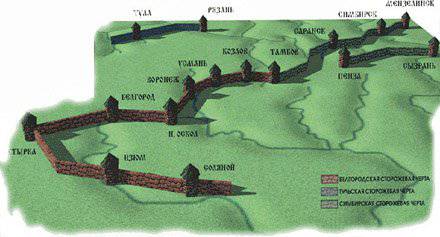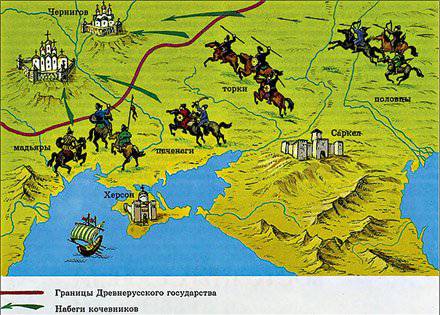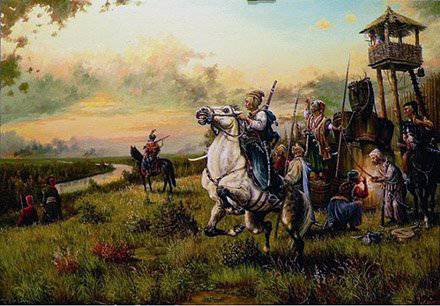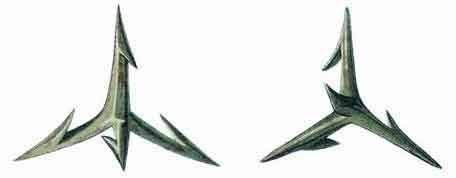Great Wall of Russia

In 2004, a pillar with the inscription "The border of Russia from 1656 to 1736 r. Was installed on the old earthen rampart in the area of the point of Mullovka, Melekessky district, Ulyanovsk region." Speech is about the Great Dirt Line. The unique defensive line was a continuous chain of fortifications thousands of miles long, protecting the country from total annihilation for hundreds of years. As frontier fortresses of Traits, dozens of cities and towns of our hinterland, which are the heart of Russia, which, in fact, is Russia, arose!
Wild Field
Our ancestors lived in the forest zone, their lands occupied vast territories, and the borders in the south coincided with the natural transition line of the forest to the steppe. Further the world of nomads extended - the Wild Field. Its owners changed: the Khazars, the Pechenegs, the Polovtsy ... The steppe lived ravishing raids, and to protect its lands from it, Russia built defensive lines in dangerous directions. Thus, on average, the Dnieper region has remnants of “Serpent Shafts”: 2000 years ago, they helped the Rus to restrain the nomadic Sarmatians until reinforcements came. Later, the Old Russian state surrounded Kiev with fortresses connected to full boundaries: Posulsky, Trubezhsky, Porossky and Dneprovsky. They were guarded by border guards - small interchangeable battle groups. Taking the first blow of the enemy, they sounded the alarm, and powerful garrisons of fortress cities entered the field.
And then everything changed: the quarrels of the greedy princes, the war against their own ... The mighty country was torn to pieces of princesses; The unified border security system created with great difficulty has collapsed. The Mongol-Tatars easily took the distant defensive belt on the Sluch – Goryn – Teterev rivers, broke through the main line on Ros in 6 places at once, and the line on the Dnieper – Stugne fell. The country has been plunged.
The problems of the Steppes persist even after liberation from the yoke. Fragments of the Golden Horde - the Crimean, Kazan, Astrakhan Khanates and the Nogai Horde - began to regularly bite into Russia. Beyond the Tula, forests turned into boundless steppes. A blessed climate, fertile soil, endless meadows - and everything was depopulated. The ancient Hierodeacon Ignatius wrote: “Neither hail, nor the village, nor one soul can be seen!” The Russian peasant's souk has already touched these unique black soils, but it was deadly to live here. Through the Wild Field from the south to the north there were walks - ancient steppe roads, not obstructed in any way, without water barriers. The most significant was Muravsky Way, trodden from the Crimean Perekop to Tula. On it went still Sarmatians, Scythians, the army of Mamai went to Kulikovo Field. Since the XVI century. the knight became the headache of a clinging Russia. Horse sakmas (paths) diverged from him like a fan, leading predators to villages where Russian grain-growers, boaters, hunters, fishermen tried to take root. The wild robbery began, was taken away "all the way down to the nails of the buildings and horseshoes from the hooves of a fallen horse." But the main prey was people. Old people were killed, others were taken away for sale into slavery. That was the direct extermination of the population of Russia abroad. There was even the notion of “choose a village,” that is, to steal in full of all the inhabitants. The human losses were so great that Moscow imposed a special tax for the ransom of the Polonians, and it was paid by the tsar and his subjects. The bandits were paid through intermediaries, giving even for the commoner 250 rubles, huge money at that time! But there were still the shots of Izyum, Kalmius, Bakaev, there was a Nogai road from the Kuban — there was a horse horde going everywhere to Russia. The path to the north was not so far for her; in the winter, she easily took water obstacles on the ice, leading up to 80000 warriors. In the summer strada (it is easier to catch people in the fields), smaller forces were sent to Russia, up to 20000 sabers. To the border, the horde moved in a long column, and then divided into 10 – 12 units to hide its numbers from the Russian patrols.
Russia paid nothingness-the Crimean Khanate-a shameful tribute, "anyhow they did not bother the vile"! But the "rotten" brazen, breaking agreements, continuing the genocide. Instead of a burnt village, you can build a new one, but who should be built? South Russia is empty. The Persian Shah, receiving ambassadors from Moscow, was surprised that there were still people there. It was necessary to transfer the fight against the enemy to his territory, to the steppe. This required the strengthening of boundaries.
Belt of the Blessed Virgin
By the beginning of the XVI century. Russia united. It became possible to create a single line of defense. It was built on the left bank of the Oka, the current flowing from the west to the east of the border river between Russia and Wild Field, calling it Bereg. With a dotted line (fortresses, monasteries, jails, earthen ramparts, ditches, watchtowers), he went from Serpukhov to Kolomna, where the Oka, full of water due to the confluence of the Moscow River, was no longer to be crossed. To the west, it was shallowing, and for the barrier to the enemy, its bottom and banks were simply hammered with sharp stakes, the fords were blocked off with piles, logs with protruding spokes were laid on the bottom, their banks were reinforced with cuts and cannons. Most often, the Tatars stopped at Oka. The coast had constant garrisons, which conducted reconnaissance, took upon themselves the blow; he became a reliable defense of Moscow, and he was called the Belt of the Most Holy Mother of God. But the belt was not continuous, each city built a line to the right and to the left of itself, the passages were just beginning to stretch towards each other, into a single line.
Zaokskaya line
With the beginning of the Kazan campaigns of Ivan the Terrible, the defense was advanced to the south, arranging a grand boundary between the Bryansk and Meshchersky forests with the support of the fortified cities. In a short time, they made a lot of observations, calling them by city: Kozelsk, Kashirskys, Venevskys, Tula, Krapivenskys, Odoyevskys, Likhvinskiy, Peremyshlskys, Belevskys, Ryazan. In contrast, they spotted the Shores at once led by a single line, building a deeply echeloned defense. In treeless places, it doubled (between Tula and Venev), tripled (Belev – Likhvin), quadrupled (Belev – Peremyshl). The southeastern flank held the Ryazhskia notch, which was especially important, because Muravsky Way, the Tatars' direct route to Moscow, came here. The line was also strengthened from the north in order to beat the enemy coming from the raid. The works were completed in 1566. The line unprecedented in those times stretched for 600 km and was called the Zaokskaya line, since it was along the right bank, “beyond the Oka”. Its depth was from 40 – 60 m (where there was only a ditch, shaft or swamp) to 40 – 60 km! From positions well-tied to a locality, all of it was shot by gun-guns; every 200 m (shot range) the shaft had a projection-redan so that there were no dead zones. The former simple abutments of fallen trees became a complex defensive system, they spared no effort and resources. Zaokskaya line clearly expressed the unity of Russia. It became a state, with an army for its protection and participation of the population in its arrangement.
Big Crossline
But this was not enough: with the expansion of the boundaries of the new grand defense lines turned south. After the annexation of Left-bank Ukraine, the Belgorod line with a length of 1635 km, covering the Kursk region, was built quickly (1658 – 800) in the south. It was arranged in the same way as Zaokskaya. There were no dense forests here, and it was necessary to build not abutments, but other fortifications. It strengthened the old and built new cities (20 cities in 15 years!). Simultaneously with the Belgorod Simbirsk and Zakamsky cross-border features were built in the Middle Volga region. The boundary formed by these three features stretched for 2000 km from Kharkov to the Volga region. By the end of the XVII century. It was supplemented with Izumsky / Syzran zasekami (600 km). In the XVIII century. completed the Orenburg line, cutting off the Nogais from the Kazakh steppe, and the total length detected in Russia amounted to 3700 km. Zasechnaya Trait really became big! The construction was controlled from Tula, the center of defense of the southern borders of Russia.
"Gardarika"
Scandinavians called Russia the word "Gardarika", "the country of cities." There were a lot of them. In the west, the onslaught of Poland, Lithuania, Sweden and the Germans of the Livonian Order was met by a multi-tiered high-rise defense, embodied in detached stone multi-tower fortresses: Novgorod, Pskov, Smolensk, etc. In the south and east, a large mobile nomad attacked him - he was met by a horizontal multi-line defense, wooden fortresses with chisels. On the line "Coast" it was 9 cities from Kozelsk to Nizhny Novgorod; Zaokskaya line already included more than 40 cities; Belgorod line made 27 fortresses, then added another 29. The cities had garrisons in 500 – 1500 sabers and a large number of guns (up to 37 in Rylsk); in the fortresses of the internal lines, considerable forces were constantly stationed, ready for a throw to the front line. In the end, the fortress blocked all the ways with which the enemy came: Muravsky blocked Tula, Nogai - Kozlov, Tambov, Lomov; Izyumskiy / Kalmytsky shlyah - fortresses of the Hard, Yablonov, Efremov. In 1615, the border towns were divided into 5 departments: 1) Ukrainian-internal, 2) Ryazan, 3) Seversky, 4) Steppe, 5) Lower. Special zones were created - 12 "custom cities" with counties where it was not allowed to give land to any ranks in order not to interfere with the local guards to protect the Devil.
The cities had 2 fences - outer (roundabout hail, ohaben or chrome) and inner (current hail, detinets or kremlin). At first they were rounded, but then they straightened, because a dead zone appears at the rounded wall. In the corners and on the long sections of the wall, towers of height 10 – 12 m, protruding behind the wall on 2 – 3 m, were installed. They were square / hexagonal, several floors, firing (for guns / throwing machines) and travel (with gates). The highest was the watchtower with a tower. The watchmen took attentive watchful warriors, recognizing their own from afar by gait, watching the terrain around the clock and sounding the alarm, even with a hint of danger. Inside the fortress they made a temple, a house of the governor, barns, a powder magazine, and a siege yard to shelter the local residents during the raid. They did everything to repel attacks both from the south and from the “Russian” side, with the possibility of shelling and the courtyard. Although the nomads had no artillery, the armored fortresses were built taking into account cannon combat and defense against other possible enemies.
Splicing technique
Natural obstacles were included as much as possible into the defensive line: rivers, swamps, ravines, cliffs, but they were also “brought”. In the dense forest between fortresses and outposts, continuous coffers hundreds of kilometers long were made, a natural man-made fortress through which "no one walked, the gray beast did not flit, the black raven did not fly by." It was a blockage block width 50 – 100 m, for which part of the forest was “spotted”: trunks were cut at 1 m height and piled crosswise towards the enemy, to the south without cutting off the stumps, so the trees lying in the rubble continued grow. Peaks and branches sharpened, all tied up with ropes from the bark, and it was impossible to pull apart the blockage. In addition to the simplicity and speed of the dispensation, the cut often was impassable, even for a walking man. In the rear, in 25, the narrow stitch walked along it, along which only the horse zasenny watchman traveled. Behind a zasechny line rokadny roads were laid. In the woodlands poured earthen ramparts, dug ditches, weavers made.

The trees and ditches stretched for dozens of miles. Watchtower stood at a distance of direct visibility. The effectiveness of the defense was reinforced by all sorts of small things: wolf pits in the form of a truncated cone depth to the height of a person, with a diameter of 50 bottom, with a sharp stake driven into the bottom; poles - pointed logs dug in a checkerboard pattern in the 4 row beyond the outer edge of the ditch with a slope towards the front; Chastik - sharp stakes scored close to each other in the berm between the wall and the moat; iron knitting boards, inverted harrows, slingshots, spears with iron hooks, spiked cast iron cores, crossbows, etc.
Century watch
Defense Traits were assigned to the intersection guard. She lived in her own villages, reinforced by need from the city or surrounding villages (1 people with 20 yards / 3 yards for 15 km from Dash / s 5 yards for 25 km from Dash). Received from the treasury weapon, gunpowder, lead. It was a gross, zasechnoe matter, the elimination of damage, the "removal of poru" the local population. For conscientious service the watchmen increased land allotments, encouraged money. On the 3 year of service, 3 rubles were issued for the purchase of a second horse. When changing the watchmen, the old ones vouched for the new ones. Everything was done to densely populate the line features. Service Tatars, the local aboriginal population (Mordovians) went into custody. The wicked tsar wisely ordered the fugitive people to be taken into custody! Here serfs, criminals fled, and simply in search of a better life. By decrees, they were forgiven and accepted into service; even the Smolensk gentry, captured in the war with Poland, were settled for a while or “for everlasting life”. All these people received land, were exempted from taxes, and when the enemy appeared, they fought for their homes and thus for the rest of Russia. Soon the number of settlers so increased that they put up horse riders to 35000!
The guard clearly functioned throughout the steppe border from the Dnieper to the Volga, was strictly controlled, the negligent were punished. They served in such a way that “so that without watchmen there would not be a single hour until the great snow falls.” The advanced posts kept constant observation from ancient Scythian burial mounds, visible until now in the south of Russia, at a distance of direct visibility, sentinel-signal towers were arranged. The news of the enemy was transmitted with the help of smoke and mirrors. For better visibility and deprivation of enemy cavalry, extensive grass burns were undertaken. Usually, the enemy was found even before its approach to the Devil, the inhabitants were hidden in fortresses, cattle in the forests, and the garrisons took positions with the task of holding, exhausting and weakening the enemy. In 1572, the guard service played a significant role in the total defeat of the Crimeans at Molodya.
In addition to the stationary guards on the Devil there were mobile patrols. From 1 of April to 1 of December, the village of Dick Pole, mobile outposts from 50 – 100, walked in patrolling the border sector allotted for them with a width of 30 – 50 km. The personnel were divided into 8 queues, each carrying the service of the week's 2. By July 15 the whole outfit was exhausted, and the second stage began in the same manner. If the weather contributed to the raid, the patrols began earlier and ended later. When the autumn thaw made roads impassable, everyone returned home, and until early spring the line was not guarded by anyone. Forward travels were sent from the villages - guards with force up to 6 people leaving for 4 – 5 daytime exits from the Trait; lying on the steppe Sakmas, fords, they watched their site. Seeing the dust of the moving horde, galloping with the message to the next watchman, and so the alarm quickly reached the fortress.
The Cossacks, who covered particularly dangerous areas, took an active part in the creation and protection of the notching lines. The “Ryazan Ukraine” on the Don / Azov side was blocked by the Cossacks “Ryazan”. Familiar with local conditions, they pursued Crimeans in Dick Pole, fought off prey and prisoners. The Putivl Cossacks watched the Seversk lands along the Dnieper from Lithuanians. On the Volga and "Kazan Ukraine" stood "Meshchersky" Cossacks - detachments of Tatar servants of princes with the center in Kasimov. "Donetsk" guarded Muravsky Way, "shatskie" - Nogai road. There were Cossacks “Sevryuki”, “Whitelands”, “City” etc. Cossacks played an important role in the steppe patrol, tracking the enemy all year round, maintaining communication between the frontiers. Their exact number at the end of the XVI century: Putivl - 138, Ryazhsk - 500, Yelets - 600, Novgorod-Seversky - 103, Pronsk - 235, Mikhailov - 400, Dankov - 500, Dedilov - 376; in the middle of the XVII century. the number reached the 15000 sabers. Long-distance reconnaissance, leaving the watchman hundreds of miles from the line, was also on the Cossacks.
Management: "sovereign affair"!
The state kept a watchful eye on the state of the Dash. He was responsible for her Pushkarsky order with clearly defined functions. The population paid a tax to strengthen the Traits ("zasetsky money"). Foreign lands were governed by governors appointed personally by the sovereign. In the fortresses were military governors, siege heads, commandants of the garrisons. Administratively, the zaseki were divided into links with the manager, the notch head, who was obliged to "meet the enemy with every fight." He expelled reconnaissance, monitored the serviceability of the fortifications, organized a “tithe of tillage” of land to replenish state-owned grain stocks; subordinate servants and watchmen submitted to him.

Zasechnye forests were on the protected mode: it was forbidden to plow, mow hay, chop trees, hunt, pick mushrooms, berries, and even just go into the forest, "so as not to put stitches." For damage to buildings and felting fined and even executed! A fine was also collected from the watchmen. Passing through the zaseki was possible only in certain places - the gates. The results of the patrol and works were to be written off by the sovereign himself! And Ivan the Terrible himself accepted the Zaokskaya line, who had been touring it with “all the service people” for a whole month. There were rules for inspection (“there were no bare spots”); devices for blockages (“carry the tree for the outside from outside, and take the fence for the obstruction only, so as not to bare the cut”); orders for work. The notch business reached a high level in Russia, the defense complex of the frontiers was maintained at a high level for centuries.
Experience the Power of Effective Results
Hundreds of battles took place on the Devil. The chronicle reports about the raid on Tula in 1518: “They spotted roads and beat many Tatars through the forests, sank along the rivers, and caught some other living”. A huge horde was reflected in 1521 and 1531 near Belev, in 1534 in Bebrik near Belev; in 1565, they successfully beat off in Bolkhov. Every year, going on a raid, the enemy in 38 years (1558 – 1596) managed to break through to Russia only 2 times. He succeeded, as a rule, with the help of traitors. So, in 1571, the boyar Sumarokov led the horde through the zaseki and the Oka - and Devlet-Girey burned Moscow, killed the 60000 inhabitants, and took as many prisoners.
"Cutting" the forests of the Rus invented at dawn stories and used until the XIX century. Considering the length of the borders, the terrain, the tactics of the equestrian nomad, the serif features were the most optimal military engineering method of protecting the Russian land.
From our dossier
Small fortification was a jail. It had a rectangular shape, a back with loopholes, 4 towers in the corners and 1 gate, 2 – 3 guard houses. Outside, a circular dry / water moat with a depth of 3 m at a distance 1,5 m from tyn was made. Effective against the unskilled enemy in military affairs, the fortress was used on the borders with nomads; were residential, with a population, and standing, for a shift service for 50 fighters.
From our dossier
Observation posts “bird's nest” were made (“to sit on tall trees day and night, keeping the body ready with birch bark and tar, which they light up in view of the enemy”). Here and there, “holes” were left on the defensive, in order to put the enemy in depth, to spot, surround and destroy. Difficult labyrinths in the age-old forest led the column, opening the glades and awakening the hope that "this damned forest will soon end", because "Steppe is afraid of the forest." The stranger did not suspect that he was followed by dozens of vigilant eyes. And then it suddenly turned out that there was no further way, the beating of the “uninvited” began, and they left their lives here, coming for the lives of others.
From our dossier
A typical example: the ancient Russian fortress Sudzha at the intersection of ancient Slavic roads to the southern seas and Tatar trails to Russia; it was surrounded by 3 rivers, marshes, moat, ramparts, oak walls with 14 towers and 4 gates; outside there were wooden earthen bastions with cannons / pischalyami, inside in case of holes in the walls - movable log cabins. Lifting bridges led across the moat and the river. In the center stood a burg with a high travel tower surrounded by a moat, a rampart and an oak tyn. There was a courtyard's courtyard, a guard hut, a powder magazine. In Sudzha there were 260 courtyards, behind the wall - another 522 courtyard. In the XVIII century. The fortress lost its military significance, and no trace was left of it.
From our dossier

Garlic counter-anti-personnel barrier: a three-dimensional figure made of sharp steel spikes made of 4 and connected at an angle of 120 ° to each other in all planes. The length of the 5 spikes is cm, the thickness of the 1 cm, can be notched, like on a fishing hook. The shape of the product always ensures its position with one spike upwards, the rest provide a stable support. Virtually invisible in grass and snow; use effectively with at least three products on 1 m 2 and depth of field 100 – 150 m. Effective against cavalry; when attacking, the spike pierces the hoof and puts the horse out of action immediately (falling, crushing the rider under itself), at best, it crashes for months, remains lame, at worst dies in a few days from blood poisoning. Under Poltava, the flanks of the Russian army covered 6000 pounds of garlic; near Borodino - already 72000 pounds, which disrupted Napoleon’s plan to go around the left flank of the Russians with a cavalry; in 1914, stocks of "garlic" in the warehouses of the Russian army were 400000 poods, but it was not used. In Vietnam, the Yankees tried to use boots with steel plates in the soles for protection, but at a density of more than 1 products on the foot area “garlic” slows down even in special shoes with a thick sole. The structure of the attackers is broken, they are concerned about the care of their feet, they are not up to fire on the enemy.
Information